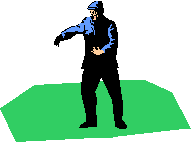|
 DEWEY
GAME DEWEY
GAME
A combination of Twister and Bingo this little game
is a beginning lesson for second semester second-graders and
first-semester third graders. They can put their whole bodies into
this.
MATERIALS (for half a class / 15 students)
-
1. Dewey Bookmarks
from Demco listing the 10 Dewey categories and their
basic contents.
-
2. 10 old CDs, such
as those that come in the mail.
-
3. 15 squares of
colored vinyl, each about 26" on a side. Vinyl can be
purchased by the yard from fabric stores such as JoAnn Fabrics.
-
4. Numbers,
0-9 and 7" high, created on the computer and glued onto
medium weight cardboard, then cut out with scissors or an Exacto
knife as templates for the numbers on the vinyl.
-
4. Vinyl by
the yard, computer and paper, medium-weight cardboard, permanent
marking pen, yard stick, t-square, ball point pen, Exacto knife,
scissors.
CONSTRUCTION
-
1. On one CD
using the permanent marker, write the numbers for the first Dewey
division (000) in large print. If you need prompting yourself,
write the contents of the division in small print. Repeat with
the next nine CDs, giving each one a different Dewey division.
These are your "bingo" calling chips.
-
2.
Using a straight edge, perhaps even a t-square, mark the vinyl with
ball-point pen into 26" squares. Cut the squares with
scissors.
-
Using a straight edge and the permanent marker,
mark each vinyl square diagonally from corner to corner. This
will produce four isosceles triangles that meet in the middle.
Let the mats dry.
-
Using the cardboard numbers as templates, write
one Dewey division number in each of the four sections of a vinyl
mat with the permanent marker. Let the mats dry. If you
can think of something to use to paint over the marker that will
seal it, so much the better. Otherwise, you may wish to store
them flat rather than rolled up, with paper towel between them to
keep them from bleeding on to the touching vinyl mats.
-
Here are the numbers I have on my mats. Or
you may prefer to do your own arithmetic. Whichever way, be
sure that there are no duplicate mats.
-
000, 400, 600, 800
-
000, 300, 400, 600
-
100, 200, 300, 700
-
200, 300, 500, 700
-
100, 300, 500, 900
-
400, 600, 800, 900
-
100, 200, 500, 600
-
200, 600, 800, 900
-
200, 300, 400, 500
-
000, 400, 500, 600
-
000, 400, 500, 900
-
000, 300, 500, 700
-
100, 500, 800, 900
-
100, 200, 400, 700
-
300, 500, 700, 900
PLAYING THE GAME
1. Give each child a mat and tell him to place
it on the floor in front of him/her, so that he or she is standing with
one mat in front of him/her and facing you.
2. Pass out the Dewey Bookmarks, one to each
child.
3. Shuffle the CDs. Select one of the CDs
and call out its category title, not the numbers. Students
must look on their bookmarks, find the title, find the number that goes
with it (Social Science -- 300) and look on their mats to see if they
have 300. If so, they put one foot on the mat in the 300
triangle. Call out another category. Students repeat their
process and if they have the second number, put the second foot on that
triangle. Third is for one hand; fourth is the other hand.
At this time the student calls out, "DEWEY!"
4. He or she has won the first round.
Give student an inexpensive prize, such as a plastic spider ring, and
you go again. About 3 or 4 rounds is plenty in one session.
Students keep bookmarks and prizes.
5. In another session, play without the
bookmarks and let the students cooperate to figure out the number for
the category.
|